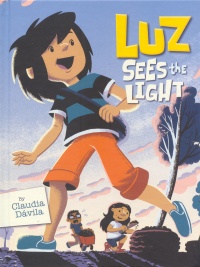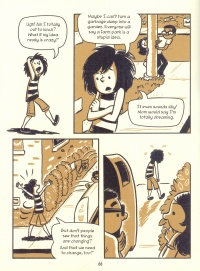| ________________
CM . . . . Volume XVIII Number 11 . . . . November 11, 2011

 |
Luz Sees the Light.
Claudia Dávila.
Toronto, ON: Kids Can Press, 2011.
96 pp., pbk. & hc., $8.95 (pbk.), $16.95 (hc.).
ISBN 978-1-55453-766-2 (pbk.), ISBN 978-1-55453-581-1 (hc.).
Grades 3-6 / Ages 8-11
Review by Harriet Zaidman.
**** /4
|
| |
|

excerpt:
“Ah, Saturday. A perfect day to go to the mall.”
“What, again?”
“If we go, let’s make it a bike ride. Sound good?”
“Good? Sounds like torture!”
“Chica, gas is too expensive! We need to save some money. I don’t want to use the care so much.”
“C’mon, I just want to see if my sneakers are at the stores yet. We’ll be quick!”
Luz Sees the Light is a nicely written and illustrated graphic novel that does a commendable job selling the environmental message of responsible use and sustainability to children. Claudia Dávila’s story has believable characters with a full range of emotions and experiences. She is also a skilled artist whose black, white and gold illustrations make good use of the graphic novel format.

Luz is a North American urban kid from a single parent Latino immigrant family. They live on a tight budget, but she nags her mother to waste money on gas by driving her on frivolous shopping trips and by insisting she buy things they can’t afford. The city where they live is in trouble, too, as frequent electrical blackouts disrupt life as we have come to know it. An eccentric neighbour predicts doom and stocks up on canned goods; an older couple from “the old country” eat fresh and save money on food by growing vegetables in their yard.
A new kid on the block is a computer geek who goes into crisis whenever the electricity fails. As their lives are impacted, it’s clear that Luz and Robert are selfish and in poor physical shape. Luz ‘sees the light’ and decides to clean an empty lot that has become a dumping ground. At first, she encounters resistance from Robert, the neighbourhood and city officials, but she presses ahead anyway. Her persistence wins over her friends; Robert’s computer skills come in handy when it comes to spreading the word about the new community playground, garden and park they’re building. More people are attracted to this positive activity, and they learn that “We can all help each other in so many ways” by growing and buying local food, recycling and composting, and, most of all, working together. Everyone is healthier, everyone is happier.
Dávila has divided the story into chapters, an approach which gives the story the qualities of a typical novel. The characters look realistic but they display exaggerated expressions at the right times, such as when Luz lusts after a pair of over priced running shoes, or when vegetarian Robert realizes he’s eating rabbit stew. Dávila draws the frames from a variety of points of view without overdoing it, making the drawings interesting to look at without being too busy. There’s lots of kid humour in the text as well as the illustrations.
Luz is an ordinary kid who realizes she can make a difference. She’s a good role model for kids in the target age range who are thinking about how they can help the community, locally and globally. The graphic novel format will make this book appealing to readers of all levels, who will both identify with Luz’s angst and enjoy the comic book representation of the story.
Highly Recommended.
Harriet Zaidman is a teacher librarian in Winnipeg, MB.

To comment
on this title or this review, send mail to cm@umanitoba.ca.
Copyright © the Manitoba Library Association. Reproduction for personal
use is permitted only if this copyright notice is maintained. Any
other reproduction is prohibited without permission.
NEXT REVIEW |
TABLE OF CONTENTS FOR THIS ISSUE
- November 11, 2011.
AUTHORS |
TITLES |
MEDIA REVIEWS |
PROFILES |
BACK ISSUES |
SEARCH |
CMARCHIVE |
HOME |

